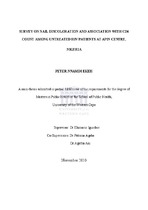| dc.contributor.advisor | Igumbor, Ehimario | |
| dc.contributor.advisor | Agaba, Patricia | |
| dc.contributor.advisor | Ani, Agatha | |
| dc.contributor.author | Ekeh, Peter Nnamdi | |
| dc.contributor.other | School of Public Health | |
| dc.contributor.other | Faculty of Community and Health Sciences | |
| dc.date.accessioned | 2013-06-14T07:51:22Z | |
| dc.date.available | 2013/03/04 12:38 | |
| dc.date.available | 2013/03/04 | |
| dc.date.available | 2013-06-14T07:51:22Z | |
| dc.date.issued | 2010 | |
| dc.identifier.uri | http://hdl.handle.net/11394/1431 | |
| dc.description | Magister Public Health - MPH | en_US |
| dc.description.abstract | Eligibility for antiretroviral therapy (ART) in HIV-infected patients is defined either by a cluster of differentiation antigen 4 (CD4) count of less than 200cells/mm3 or clinical diagnosis of WHO stage III and IV. Therefore, the decision to start ART becomes difficult when CD4 cell count is not available. With limited laboratory infrastructure, the decision to start ART is usually made based on clinical symptoms leading to late commencement of ART. This calls for alternative criteria to see if nail discoloration (ND) correlates with low CD4 count among untreated HIV infected patients. This will serve as a complementary screening tool for identifying asymptomatic ARV naive HIV patients with a CD4 cell count of less than 200cells/mm3 which signifies severe immunosuppression. Study Design and Setting: This was a quantitative cross-sectional descriptive and analytical study involving adult ART naïve HIV infected patients in WHO stage I and II. Systematic sampling was used to select the participants from all adult ART naïve HIV infected patients attending APIN clinic, located at the Jos University Teaching Hospital (JUTH), Jos, Nigeria. Data Collection: Face-to-face interviews, physical examination and relevant laboratory investigations with selected participants were conducted using a questionnaire guide. Questions on socio-demographic characteristics, clinical data, general physical examinations including finger nail examination and photographing with subsequent laboratory investigations including CD4 count and western blot were employed. Data Analysis: Variables were categorized and data analyzed using descriptive statistics including the frequency, percentage frequency; mean and standard deviation of continuous variables. Association between CD4 count of ≤200cells/mm3 and ND was tested using the chisquare test with an alpha level of 0.05. Prevalence of ND, sensitivity, specificity, positive predictive and negative predictive values and accuracy of the screening test of ND was calculated. Results: 394 patients had their fingernails photographed and assessed. It was shown that distal banded and grey nails were the common types of ND seen with a prevalence of 38%. There was an association between CD4 count ≤200cells/mm3 and ND (p<0.0001). CD4 count ≤200cells/mm3 was a risk factor for developing ND (RR=2.3[1.8-3.6]). The association has a sensitivity of 78%, specificity of 55%, positive predictive value of 50%, and negative predictive value of 80% and accuracy of test 63%. Conclusion: With a significant association (p<0.0001) and a sensitivity of 78%, ND can be a useful clinical indicator of immune dysfunction mediated by HIV among patients in WHO stage I or II. ND can either be a clinical sign or a symptom in HIV patients with a CD4 of ≤200cells/mm3 as seen in the study as the specificity and sensitivity of ND compared favourably with other WHO stage III diagnosis. Recommendations: Nail discoloration should complement CD4 count as an additional staging sign to help identify patients likely to benefit from ART especially in resource-limited settings. Finally, all patients with grey or distal banded should be on co-trimoxaxole prophylaxis in line with WHO /national guideline on the use of co-trimoxaxole for all HIV positive patients with a CD4 cell count of ≤350cells/mm3. | en_US |
| dc.language.iso | en | en_US |
| dc.publisher | University of the Western Cape | en_US |
| dc.subject | Human immunodeficiency virus | en_US |
| dc.subject | Acquired immune deficiency syndrome | en_US |
| dc.subject | Cluster differentiation of antigen 4 | en_US |
| dc.subject | Antiretroviral therapy | en_US |
| dc.subject | Nail discoloration | en_US |
| dc.subject | WHO HIV taging | en_US |
| dc.subject | Alternative criteria | en_US |
| dc.subject | Dyschromonychia | en_US |
| dc.title | Survey on nail discoloration and association with CD4 count among untreated HIV patients at Apin Centre, Nigeria | en_US |
| dc.type | Thesis | en_US |
| dc.rights.holder | University of the Western Cape | en_US |
| dc.description.country | South Africa | |

